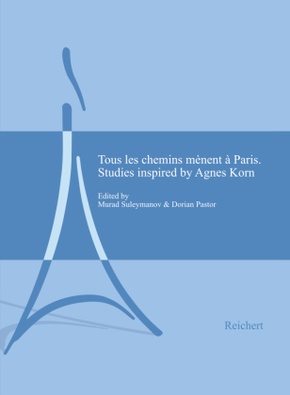
Tous les chemins mènent à Paris - Studies inspired by Agnes Korn
| Verlag | Reichert |
| Auflage | 2022 |
| Seiten | 180 |
| Format | 17,9 x 1,6 x 24,6 cm |
| Gewicht | 486 g |
| Artikeltyp | Englisches Buch |
| ISBN-10 | 3752006943 |
| EAN | 9783752006940 |
| Bestell-Nr | 75200694A |
This volume is a collection of nine papers by various authors focussing on issues of etymology, historical language contact, morphology and syntax, typological modelling, and folk practices in the Caucasus-Iran-Central Asia area and its immediate vicinity. The volume is a humble token of appreciation offered by the authors to Dr Agnes Korn to honour her continuing support for young researchers during her time in Paris and to highlight her wide array of research interests.
This volume honouring Dr Agnes Korn's continuing support for young researchers is a collection of nine papers contributed by authors whose careers and lives have been touched by Dr Korn's academic guidance and personal mentoring during her time in Paris as a chargée de recherches at CNRS. The topics covered in the chapters highlight Dr Korn's wide array of research interests, encompassing cultures and languages - both classical and modern, written and oral, well-known and underdescribed - of the Caucasus-Iran-Central Asia area and its immediate vicinity.
The book consists of a preface and an introduction, as well as chapters presenting novel research, influenced directly or indirectly by Dr Korn's deep academic involvement. The chapters, each reviewed by one referee under a double-blind peer review process, deal with issues of etymology, historical language contact, morphology and syntax, typological modelling, and folk practices.
Bernard (pp. 15-24) explores the ety mology of Mazandaran, the name of a province situated in Northern Iran. Chamot-Rooke (pp. 25-36) analyses the use and origin of smam, a previously unacknowledged Tocharian A lexical item. Gérardin (pp. 37-71) introduces a new typological approach to classifying and describing the valency of Georgian verbs. Jügel (pp. 73-91) suggests that linguistic areas with a dominant religious affiliation may be considered a factor influencing the historical dialectology of Persian. Kontovas (pp. 93-106) presents an overview of the reflexes of Proto-Iranian _w- in modern and classical Iranian languages with the intention of determining if language contact has affected their distribution. Mascagni (pp. 107-121) provides a comprehensive description of a traditional Baloch string instrument, the sorud, and reflects on the process of repairing and tuning this instrument, which he has documented. Pastor (pp. 123-150) examines processes of degrammaticalization of the pronominal clitic =(e)s in colloq uial Persian leading to the derivation of new lexical items. Rochant (pp. 151-163) proposes a new way of looking at the nominal inflection paradigm of Andi after analysing the behaviour of a formative encountered in specific lexical classes. Finally, Suleymanov (pp. 165-178) illustrates a phenomenon of syncretism in a Tat variety which codes possessor and source in an identical manner and delves into the question of its origin.
The current volume may be of interest to linguists specializing in Iranian and other Indo-European, as well as East Caucasian (Nakh-Dagestanian) and South Caucasian (Kartvelian) languages. The chapter documenting musical practices of the Baloch minority of Oman may equally appeal to ethnomusicologists.
